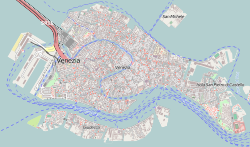| Italian Synagogue | |
|---|---|
Italian: Scuola Italiana | |
 The synagogue façade, from the square of the Ghetto Nuovo, in 2015 | |
| Religion | |
| Affiliation | Orthodox Judaism |
| Rite | Italian rite |
| Ecclesiastical or organisational status | Synagogue |
| Status | Active |
| Location | |
| Location | Jewish Ghetto, Venice |
| Country | Italy |
Location of the synagogue in Venice | |
| Coordinates | 45°26′42″N12°19′36″E / 45.4451°N 12.3266°E |
| Architecture | |
| Type | Synagogue architecture |
| Style | Baroque |
| Completed | 1575 |
| Specifications | |
| Capacity | 25 seats |
| Materials | Stone |
| Website | |
| jvenice | |
| [1] | |
The Italian Synagogue (Italian : Scuola Italiana) is an Orthodox Jewish congregation and synagogue, that is located in the Jewish Ghetto of Venice, Italy. Completed in 1575, it is one of five synagogues that were established in the ghetto. [2] [3]
